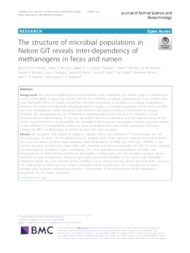The structure of microbial populations in Nelore GIT reveals inter-dependency of methanogens in feces and rumen.
The structure of microbial populations in Nelore GIT reveals inter-dependency of methanogens in feces and rumen.
Author(s): ANDRADE, B. G. N.; DONATONI, F. A. B.; CUADRAT, R. R. C.; TIZIOTO, P. C.; OLIVEIRA, P. S. N. de; MOURÃO, G. B.; COUTINHO, L. L.; REECY, J. M.; KOLTES, J. E.; WALSH, P.; BERNDT, A.; PALHARES, J. C. P.; REGITANO, L. C. de A.
Summary: The success of different species of ruminants in the colonization of a diverse range of environments is due to their ability to digest and absorb nutrients from cellulose, a complex polysaccharide found in leaves and grass. Ruminants rely on a complex and diverse microbial community, or microbiota, in a unique compartment known as the rumen to break down this polysaccharide. Changes in microbial populations of the rumen can affect the host?s development, health, and productivity. However, accessing the rumen is stressful for the animal. Therefore, the development and use of alternative sampling methods are needed if this technique is to be routinely used in cattle breeding. To this end, we tested if the fecal microbiome could be used as a proxy for the rumen microbiome due to its accessibility. We investigated the taxonomic composition, diversity and inter-relations of two different GIT compartments, rumen and feces, of 26 Nelore (Bos indicus) bulls, using Next Generation Sequencing (NGS) metabarcoding of bacteria, archaea and ciliate protozoa.
Publication year: 2020
Types of publication: Journal article
Keywords: Archaea, Bactéria, Bos Indicus, Gado Nelore, Metabarcoding, Methanobrevibacter, Microbiome, Microbiota
Observation
Some of Embrapa's publications are published as ePub files. To read them, use or download one of the following free software options to your computer or mobile device. Android: Google Play Books; IOS: iBooks; Windows and Linux: Calibre.
Access other publications
Access the Agricultural Research Database (BDPA) to consult Embrapa's full library collection and records.
Visit Embrapa Bookstore to purchase books and other publications sold by Embrapa.

